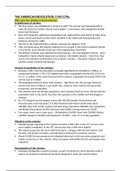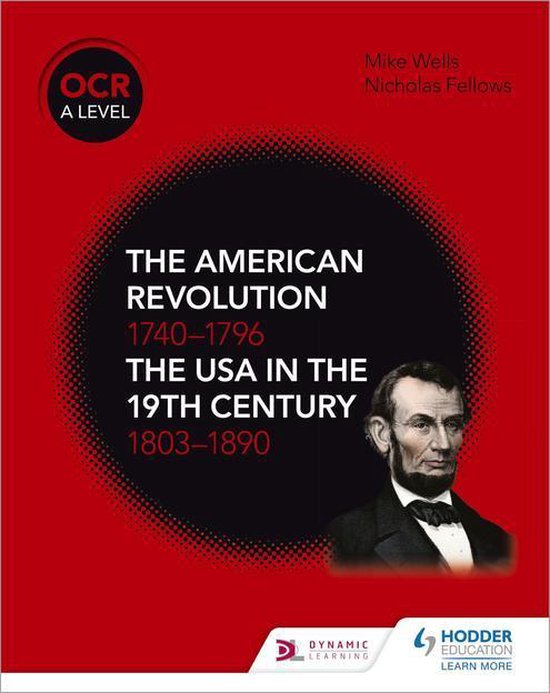THE AMERICAN REVOLUTION 1740-1796:
Who were the colonists in North America?
Establishment of colonies:
The first colony was established in Virginia in 1607. The second was Massachusetts in
1620. By 1650 four further colonies were added – Connecticut, New Hampshire, Rhode
Island and Maryland
New York (originally called New Amsterdam) was captured from the Dutch in 1664. New
Jersey, North and South Carolina were founded in the 1660s and Pennsylvania and
Delaware during the 1680s
The last of the original thirteen colonies, Georgia was added in 1732
They stretched along the Atlantic seaboard from Canada in the North to Spanish Florida
in the South, most colonists lived east of the Appalachian mountains
The thirteen colonies were divided into three groups – the new England colonies – New
Hampshire, Maine, Rhode Island and Conneticut; the middle colonies – New York, New
Jersey, Pennsylvania and Delaware; the southern colonies – Maryland, Virginia, North
Carolina, South Carolina and Georgia
Increase in population of the colonies:
Between 1700-1763 the population increased eightfold from 250,000 to 2 million. In
comparison between 1750-1770 England and Wale’s population rose by only 15% from
6.5 to 7.5 million. In the same time period the colonies’ population increased 100% from
1.25 to over 2.3 million
The population grew for three main reasons – high birth rate, the average American
woman had seven children, a low death rate, Americas were well fed and generally
prosperous, and immigration
The colonies were not densely populated, most colonists lived on farms. Almost half the
population lived in the south, the other two quarters in the middle and New England
colonies
By 1770 Virginia was the largest colony with 500,000 people, Pennsylvania and
Massachusetts each had about 275,000; Maryland and North Carolina had about
200,000; New York, South Carolina and New Jersey had about 100,000; New Hampshire
and Rhode Island about 50,000; Delaware had 40,000; Georgia had only 30,000
Five major towns were major ports – Philadelphia (24,000), New York (18,000), Boston
(18,000), Newport (10,000) and Charleston (10,000) – only 3.5 % of the population
Migration to the colonies:
400,000 people migrated to the colonies between 1700-1763, in the 17 th century most
were English immigrants, in the 18th century less than a fifth were English
The largest group was the Scots-Irish Protestants, unhappy with the land system, bad
harvests and decline of trades, most left their homeland for economic reasons
About 65,000 German peasants also migrated attracted to the economic prospects and
religious tolerance in the colonies, other European nationalities (Dutch and Swedes also
migrated)
Demographics of the colonies:
European immigrants crossed in groups, as part of schemes or more typically under a
system of temporary indentured servitude designed to meet the colonies labour
, shortage. The system allowed migrants free passage by entering into a contract pledging
their labour for a number of years - usually four. Between a half and two thirds of all
white immigrants in the colonial period were indentured servants
Slaves had arrived in the colonies from 1619, in the 18 th century the importation of
slaves soared. By 1763 there were 350,000 slaves – a sixth of the population. Demand
for slaves was so high the slave population grew faster than the white population. While
there were African slaves in all colonies, 90% lived in the South, 40% of the population in
Virginia, Maryland and Georgia and 675 in South Carolina
The European settlers did not assimilate with the Native Americans. Divided (by tribe),
less technologically advanced and severely affected by European diseases, the Natives
had struggled to stop the settlers establishing their colonies and seizing land. West of
the Appalachian Mountains, the Native Americans remained a powerful force
By 1760 half the American population was English, 15% Welsh, Scottish or Scot-Irish,
slaves 20% and Germans 8%
New England Colonies: ME, NH, MA, RI, CT
Middle Colonies: NY, NJ, PA, DE
Southern Colonies: MD, VA, NC, SC, GA
Major cities: New York, Newport, Boston, Philadelphia, Charleston
European Colonists:
Crossed in groups as part of a system
of temporary indentured servitude
designed to meet the colonies labour
shortage – free passage to America in
return for four years of labour
Between a half and two thirds of all
white immigrants in the colonial period
were indentured servants
Slave Population:
By 1763 there were 350,000 slaves
– 1/6th of the population. Demand
for slaves was so high the slave
Native America: population grew faster than the
Remained a powerful force West whiteofpopulation.
the
Appalachian Mountains While there were African slaves in
To what extent did the colonies Struggled to stop the settlersallestablishing
colonies, 90% lived in the South,
govern themselves? their colonies and seizing land of the population in Virginia,
40%
Maryland and Georgia and 675 in
Divided (by tribe), less technologically
Colonial Government:
advanced and severely affectedSouthbyCarolina
Governors:
European diseases
, In most colonies, the governor was appointed and could be removed only by the British
king, to whom he was responsible
With two exceptions. the proprietary colonies (colonies where the crown vested political
authority in the hands of certain families) of Maryland, Pennsylvania and Delaware, the
proprietor who ran the colony appointed the governor
Corporate colonies (charters granted by the king which gave them extensive authority)
of Connecticut and Rhode Island where governors were popularly elected and
responsible to the legislatures
Responsible for internal administration the governors had enormous power, in reality
though their power was limited – they could be dismissed at will by the British
government; they were dependent for revenue (including their own salaries) on the
colonial assemblies
Colonial Assemblies:
Most assemblies consisted of two houses – upper houses normally appointed by the
governor, chosen from the colonial elite, their members served as an advisory board to
the governor
Lower houses were elected, they could be summoned and dismissed and their
legislation vetoed by the governor, the power of the assemblies was considerable; they
were responsible for initiating finance bills and controlling expenditure
They represented their communities and their interests
Assemblies met in the spring or autumn for four to six weeks, as well as financial matters
they made local laws.
At least 50% (in some places 80%) of American white adult males could vote, in contrast
to 15% in Britain
However, not all white men owned sufficient property to entitle them to vote. Women
and slaves could not vote
High property qualifications to stand for office, as well as custom and deference to men
of high social standing ensured that great landowners, rich merchants or lawyers were
typically elected.
Local Government:
In New England, authority over local affairs lied in town meetings in which all
freeholders (people who owned property and didn’t rent it) had voting rights. Elected
annually, the town meetings set local taxes and chose men to administer the town’s
business. This varied from place to place and was sometimes set by either county or
parish.
British rule of the colonies:
Charters were the main method of rule attaching the colonies to Britain. However,
charters tied the colonies to the Crown rather than parliament. The governors were also
appointed and represented the Crown.
The Privy Council had joint authority with the Crown to review colonial laws
For most of the 18th century, colonial supervision rested with the Board of Trade, which
advised on colonial appointments, drew up government instructions and reviewed
colonial legislation. The secretary of state for the Southern Department also had some
responsibility, communicating with governors on policy and administration
, Other agencies like the Treasury, War Office and Admiralty also had some role in
Imperial administration.
British rule affecting the colonies lacked central control, confusion and duplication often
characterised the bureaucracy
Salutary Neglect:
In the early 18th century, the British government deemed it best not to stir up trouble in
the colonies. Given that they were 3000 miles away from Britain, the colonies were left
to their own devices. This detached policy was known was salutary neglect.
Still the common presumption in Britain that colonies were subject to Parliamentary
legislation. The colonies did not necessarily accept this view. However, before 1763, this
was not a major issue as parliament gave little attention to parliamentary affairs. Hardly
any parliamentary acts touched on the internal affairs of the colonies. Few colonists
worried about their relationship with Britain
Assess the colonies’ autonomy:
Evidence that the colonies were autonomous: Evidence of British rule:
Lower houses were elected (represented Governors had enormous power:
communities and their interests) o Responsible for internal administration
o Power of assemblies was considerable; o Appointed/ dismissed by the British Gov
responsible for initiating finance bills and Assemblies consisted of two houses – upper houses
controlling expenditure (appointed by the governor)
At least 50% (in some places 80%) of American o Chosen from the colonial elite
white adult males could vote, in contrast to 15% in o Members served as an advisory board to the
Britain governor
In New England, authority over local affairs lied in In lower house, governor could veto decisions,
town meetings in which all freeholders had voting summon/dismiss representatives
rights Charters were main method of attaching colonies to
o They set local taxes and chose men to Britain – tied to Crown rather than parliament.
administer the town’s business The Privy Council had joint authority with the
British rule affecting the colonies lacked central Crown to review colonial laws
control, confusion and duplication often Colonial supervision rested with the Board of Trade
characterised the bureaucracy (most of 18th century), which advised on colonial
In the early 18th century, the British government appointments, drew up government instructions
deemed it best not to stir up trouble in the colonies and reviewed colonial legislation
– they were 3000 miles away – colonies left to their The secretary of state for the Southern Department
own devices – salutary neglect also had some responsibility, communicating with
Corporate colonies of Connecticut and Rhode Island governors on policy and administration
where governors were popularly elected and Other agencies like the Treasury, War Office and
responsible to the legislatures Admiralty also had some role in Imperial
In proprietary colonies (Maryland, Pennsylvania and administration
Delaware), the proprietor who ran the colony
appointed the governor
How much were the colonies linked to Britain – economically, socially and culturally?
Nature of trade and economy:
Between 1650 and 1770 the colonial economy grew very successfully by 3.2% each year,
this was for a number of reasons – expanding inter-colonial trade, increased trade with





